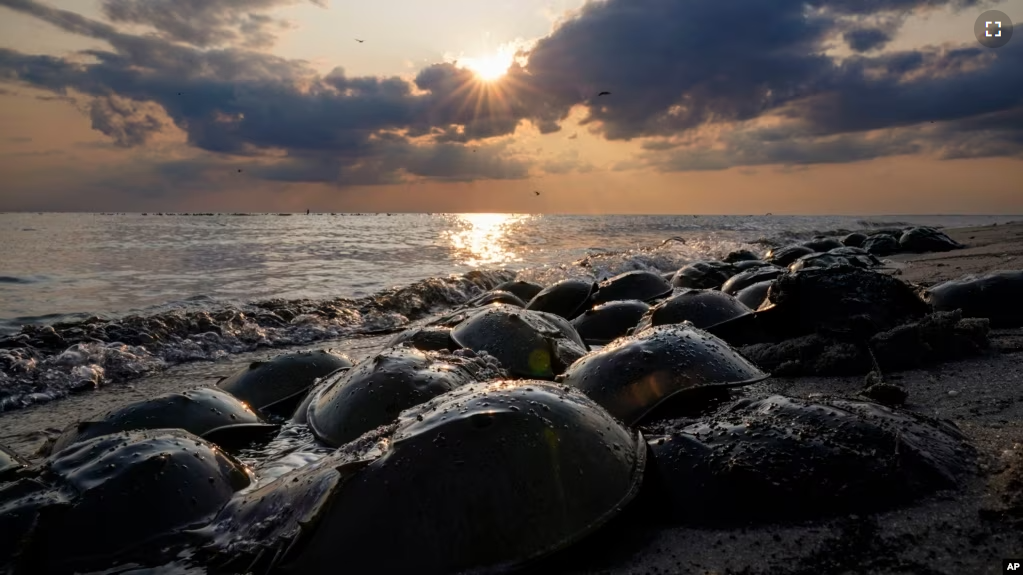New rules aim to protect horseshoe crabs, which are used in medical research, and also to support an endangered bird species.
Blue blood from horseshoe crabs is used by researchers to test for dangerous substances in vaccines, medicines and medical devices. The animals are also used by fisherman as bait to catch eels and sea snails.
In addition, the eggs of horseshoe crabs are an important food for an endangered bird called the red knot.
Scientists say horseshoe crabs have been living in ocean environments for more than 400 million years. But they are different from other crabs. They are more closely related to spiders and scorpions. The animals have been decreasing in numbers in areas they live in, called habitats, along the U.S. East Coast.
The blue blood is taken from the animals for medical research. The process returns the crabs to the environment. But many die from the blood harvesting process.
Blood from the crabs can be manufactured into limulus amebocyte lysate, or LAL, a substance used to identify dangerous substances in some medications and vaccines.
Fishermen collect the crabs by hand or with special equipment on boats for use by biomedical companies. The blood – which contains immune cells sensitive to bacteria – is then separated and proteins are processed. It takes many crabs to produce enough blood to fill a single glass tube, which contains cells that are sensitive to bacteria.
New guidelines for dealing with horseshoe crabs were approved in May by the Atlantic States Marine Fisheries Commission. Industry officials said those changes should keep more crabs alive. But, in recent years, environmentalists brought attention to the issue of the horseshoe crabs, including their relationship to the red knot.
Red knots are birds that travel about 30,500 kilometers back and forth from South America to Canada. During their long trip, the birds must stop to eat along the way and horseshoe crabs are an important food.
Bethany Kraft is a coastal conservation specialist with the environmental organization the Audubon Society. Kraft told The Associated Press (AP) that red knots need horseshoe crab eggs to give them enough fuel to complete their long flights. “There’s very clear linkage between horseshoe crabs and the survival of the red knot in the coming decades,” she added.
Kraft said horseshoe crabs currently need stronger protection to survive. She and other wildlife conservationists have noted the new guidelines are currently only voluntary. This, they say, still leaves the red knot at risk. They say the bird needs stronger legal protection.
The new guidelines urge best practices for the biomedical industry’s harvesting and processing of the crabs. They include measures aimed at limiting exposure to sunlight and keeping crabs cool and wet.
Caitlin Starks is a fishery specialist with the Atlantic States Marine Fisheries Commission. She told the AP the goal of the guidelines “is to give the crabs that are bled a better chance of surviving.”
That is exactly what the new guidelines will do, said Nora Blair, an operations official with Charles River Laboratories. The company manufactures LAL from horseshoe crab blood. Blair was a member of a working group that created the new guidelines along with other industry groups.
Blair said the industry is working to find synthetic materials that could be used for biomedical research. Conservationists have been pushing for years for such a solution. Lonza, a Switzerland-based company that manufactures LAL, offers an animal-free testing solution.
But Blair said that, for now, the wild harvest of horseshoe crabs remains extremely important for drug safety. The animals play an important part in supplying and testing drugs and the coastal environment makes their conservation “imperative,” she added.
I’m Bryan Lynn.
The Associated Press reported this story. Bryan Lynn adapted the report for VOA Learning English.
_____________________________________________
Words in This Story
species – n. a group of animals or plants that are similar and can produce young animals or plants
bait –n. a piece of foot that is used to catch fish or other animals
conservation – n. an organized effort that aims to protect animals, and natural resources
decade – n. a period of ten years
expose – v. to remove what is covering something so that it can be seen
synthetic – adj. a group of products made from artificial substances, often copying a natural product
imperative – adj. extremely important or necessary
